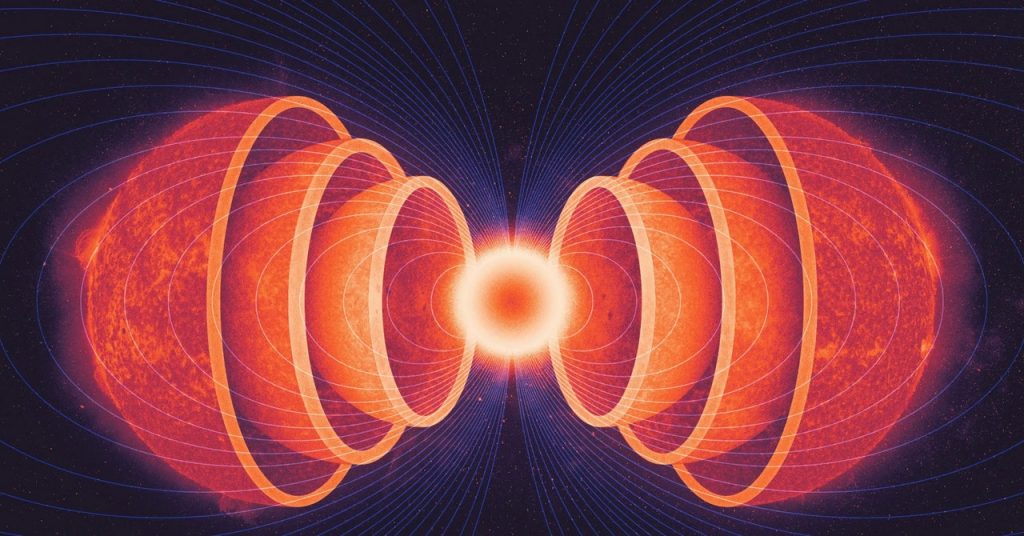Unveiling the Secrets of Stellar Magnetism through Quaking Red Giants
Probing the Heart of a Star
Asteroseismology, the study of stellar oscillations, is the key to unlocking the mysteries hidden within the core of a star. Just as seismic waves can map Earth’s interior, stellar oscillations provide a window into a star’s composition and rotation. Like a ringing bell, the shape and size of a star produce specific oscillations that reveal its properties.
NASA’s Kepler telescope has been instrumental in detecting these oscillations by monitoring the brightness of over 180,000 stars. The telescope’s sensitivity allows astrophysicists to detect minute changes in starlight linked to stellar oscillations, which affect both the radius and the brightness of the star.
The Importance of Mixed Modes
In 2011, astrophysicist Paul Beck and colleagues from KU Leuven discovered that in red giants, acoustic pressure modes (p-modes) and gravity modes (g-modes) interact to produce mixed modes. These mixed modes are the key to probing the heart of a star, as they allow astronomers to observe the g-mode oscillations that are typically confined to the core.
Studying mixed modes revealed a surprising finding: red giant cores rotate much more slowly than the star’s gaseous envelope, contrary to astrophysicists’ predictions. This discovery hinted at the possibility of a missing piece in the puzzle of stellar evolution: magnetism.
Breaking Stellar Symmetry
Gang Li, an asteroseismologist at KU Leuven, searched through Kepler’s data on red giants and found a few instances of mixed-mode signals that recorded the magnetic field in the core of a red giant. Typically, mixed-mode oscillations in red giants occur almost rhythmically, producing a symmetric signal. However, Li and his colleagues found a trio of giants that exhibited the predicted asymmetries, indicating the presence of strong magnetic fields.
One of the three red giants surprised the researchers with a backward mixed-mode signal, suggesting that the star’s magnetic field is tipped on its side. This finding opens up the possibility of determining the orientation of magnetic fields, which is crucial for updating models of stellar evolution.
The Renaissance of Stellar Evolution
Using starquakes to investigate the interiors of stars has kicked off a “renaissance” in stellar evolution, according to astrophysicist Conny Aerts from KU Leuven. This renaissance has far-reaching implications for our understanding of stars and our place in the cosmos.
Precise stellar ages are crucial for various fields, such as the search for extraterrestrial life and galactic archaeology. Knowing the age of a star can help determine the age of its exoplanets and their suitability for life. Additionally, accurate stellar ages can provide a timeline for the assembly of galaxies, like the Milky Way, which has gobbled up smaller galaxies during its evolution.
“Nature is more imaginative than we are,” she said.
The study of magnetic fields within stellar hearts is still in its infancy, and there are many unknowns when it comes to understanding how stars evolve. However, the beauty lies in the fact that there is still so much to discover and learn about the cosmos.

6 Comments
Starquakes ripping through space, revealing the magnetic mysteries of stars? Imagine the tales they could tell!
Starquakes are the universe’s mixtape, dropping new tracks on stellar magnetism!
Starquakes: Because even stars can’t resist shaking things up a bit, am I right
Starquakes shedding light on stellar magnetism? Sounds like the cosmos has more drama than a soap opera!
Honestly, stars having tantrums with starquakes just to show off their magnetic personalities is peak celestial gossip, no
Starquakes sound like the universe’s way of cranking up the bass, doesn’t it